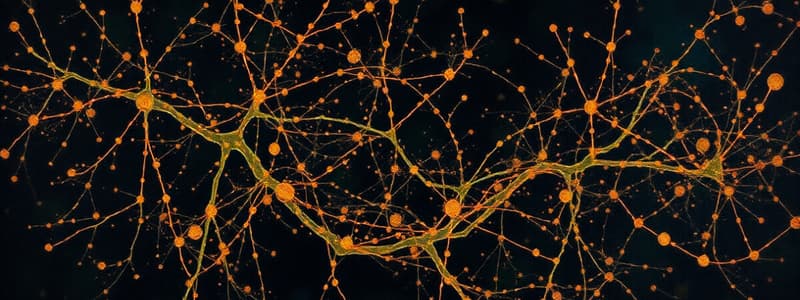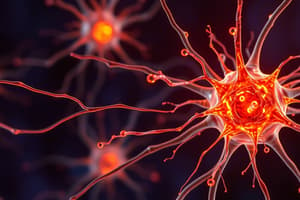Podcast
Questions and Answers
What type of channels open when an excitatory transmitter binds to its receptors during EPSP?
What type of channels open when an excitatory transmitter binds to its receptors during EPSP?
- Ligand gated Na+ or Ca++ channels (correct)
- Ligand gated Cl- channels
- Voltage gated Na+ channels
- Ligand gated K+ channels
Which mechanism involves the summation of multiple EPSPs in quick succession?
Which mechanism involves the summation of multiple EPSPs in quick succession?
- Linear summation
- Cumulative summation
- Spatial summation
- Temporal summation (correct)
What is the maximum duration of an IPSP?
What is the maximum duration of an IPSP?
- 10 ms
- 5 ms
- 1.5 ms
- 3 ms (correct)
What happens to the post synaptic membrane when the sum of EPSPs is significantly greater than IPSPs?
What happens to the post synaptic membrane when the sum of EPSPs is significantly greater than IPSPs?
What is the consequence of presynaptic inhibition in the presynaptic neuron?
What is the consequence of presynaptic inhibition in the presynaptic neuron?
Which of the following correctly describes the Grand Post Synaptic Potential (GPSP)?
Which of the following correctly describes the Grand Post Synaptic Potential (GPSP)?
What type of channel activity is associated with the hyperpolarization seen in an IPSP?
What type of channel activity is associated with the hyperpolarization seen in an IPSP?
Which statement correctly describes presynaptic facilitation?
Which statement correctly describes presynaptic facilitation?
What is the ionic basis of EPSP involving the influx of ions?
What is the ionic basis of EPSP involving the influx of ions?
What causes fatigue in synaptic transmission?
What causes fatigue in synaptic transmission?
How does synaptic plasticity adjust the function of a synapse?
How does synaptic plasticity adjust the function of a synapse?
What characterizes short-term facilitation during synaptic transmission?
What characterizes short-term facilitation during synaptic transmission?
What is the primary mechanism behind habituation in synaptic transmission?
What is the primary mechanism behind habituation in synaptic transmission?
What describes the synaptic delay during transmission?
What describes the synaptic delay during transmission?
What role does phosphorothrylation of proteins in K+ channels play during depolarization?
What role does phosphorothrylation of proteins in K+ channels play during depolarization?
What is the relationship between the number of synapses in a reflex arc and central delay?
What is the relationship between the number of synapses in a reflex arc and central delay?
What is the main ionic basis of post-tetanic potentiation in synaptic transmission?
What is the main ionic basis of post-tetanic potentiation in synaptic transmission?
Which of the following describes sensitization in synaptic transmission?
Which of the following describes sensitization in synaptic transmission?
Flashcards
EPSP
EPSP
A partial depolarization of the postsynaptic membrane, making it closer to the firing level.
IPSP
IPSP
A partial hyperpolarization of the postsynaptic membrane, making it further from the firing level.
Temporal summation
Temporal summation
Adding together EPSPs (or IPSPs) that occur close together in time at the same synapse.
Spatial summation
Spatial summation
Signup and view all the flashcards
GPSP
GPSP
Signup and view all the flashcards
Presynaptic inhibition
Presynaptic inhibition
Signup and view all the flashcards
Presynaptic facilitation
Presynaptic facilitation
Signup and view all the flashcards
Ionic Basis (EPSP)
Ionic Basis (EPSP)
Signup and view all the flashcards
Ionic Basis (IPSP)
Ionic Basis (IPSP)
Signup and view all the flashcards
Synaptic Transmission
Synaptic Transmission
Signup and view all the flashcards
Synaptic Delay
Synaptic Delay
Signup and view all the flashcards
Synaptic Fatigue
Synaptic Fatigue
Signup and view all the flashcards
Synaptic Plasticity
Synaptic Plasticity
Signup and view all the flashcards
Habituation (Short-Term Inhibition)
Habituation (Short-Term Inhibition)
Signup and view all the flashcards
Post-tetanic Potentiation
Post-tetanic Potentiation
Signup and view all the flashcards
Sensitization
Sensitization
Signup and view all the flashcards
Serotonin and cAMP effect on presynaptic K+ channels
Serotonin and cAMP effect on presynaptic K+ channels
Signup and view all the flashcards
Study Notes
Synaptic Potentials
-
Excitatory Postsynaptic Potential (EPSP):
- Partial depolarization of the postsynaptic membrane.
- Reaches maximum after 1-1.5 ms.
- Duration: 2-5ms.
- Ionic Basis: Excitatory neurotransmitter binds to receptors, opening ligand-gated Na⁺ (or Ca²⁺) channels. Influx of Na⁺ (or Ca²⁺) causes a small depolarization and brings the membrane closer to threshold.
- Summation is necessary to reach threshold. Temporal summation occurs when presynaptic neuron stimulates repeatedly, closely timed EPSPs summate.
-
Inhibitory Postsynaptic Potential (IPSP):
- Partial hyperpolarization of the postsynaptic membrane.
- Reaches maximum after 1.5-2 ms.
- Duration: 3 ms.
- Ionic Basis: Inhibitory neurotransmitter binds to receptors, opening ligand-gated Cl⁻ (or K⁺) channels. Influx of Cl⁻ (or efflux of K⁺) causes hyperpolarization, moving the membrane further from threshold.
- IPSPs can also be caused by the closure of Na⁺ or Ca²⁺ channels.
- Similar to EPSPs, IPSPs can summate temporally and spatially.
-
Grand Postsynaptic Potential (GPSP):
- Sum of all EPSPs and IPSPs occurring at the same time in one postsynaptic neuron.
- Four possible outcomes:
- Balance: EPSPs = IPSPs, no significant change.
- Facilitation: EPSPs > IPSPs (membrane does not reach firing level).
- Action Potential: EPSPs >> IPSPs (membrane reaches firing level).
- Inhibition: IPSPs > EPSPs (hyperpolarization).
Action Potential vs. Postsynaptic Potential
| Feature | Action Potential | Postsynaptic Potential |
|---|---|---|
| All-or-none law | Obeys all-or-none law | Does not obey all-or-none law |
| Graded | Cannot be graded | Graded |
| Summation | Cannot be summated | Summated |
| Propagation | Propagated | Not propagated |
| Refractory period | Absolute refractory period (1 ms) | No absolute refractory period |
| Effect of anesthesia | Blocked by anesthesia | Not blocked by anesthesia |
| Duration | 1 ms | 20 ms |
Presynaptic Potentials
-
Presynaptic Inhibition:
- Third neuron releases inhibitory neurotransmitter (e.g., GABA).
- Possible mechanisms:
- Closure of Ca²⁺ channels in the presynaptic neuron.
- Opening of K⁺ or Cl⁻ channels.
- Reduced Ca²⁺ influx decreases neurotransmitter release.
- Slow onset, lasting minutes to hours.
-
Presynaptic Facilitation:
- Third neuron releases excitatory neurotransmitter (e.g., serotonin).
- Increases neurotransmitter release.
- Possible mechanism:
- Serotonin → cAMP → phosphorylation of K⁺ channels. Closed K⁺ channels and prolonged depolarization.
- Prolonged depolarization increases Ca²⁺ channel activation, resulting in more transmitter release.
Synaptic Transmission Characteristics
- Forward Direction: Impulses flow from pre- to postsynaptic neuron.
- Synaptic Delay: Time taken for an impulse to cross a synapse (0.5 ms). It depends on the number of synapses.
- Fatigue: Decreased impulse discharge rate from postsynaptic neuron due to repetitive stimulation. Causes include depletion of synaptic vesicles and receptor inactivation.
Synaptic Plasticity
-
Ability of synapse to change function according to demand.
-
Short-term Inhibition (Habituation):
- Gradual loss of response to repeated stimuli.
- Mechanism: gradual inactivation of Ca²⁺ channels, reducing intracellular Ca²⁺, and neurotransmitter release.
-
Short-term Facilitation (Post-tetanic Potentiation):
- Brief intense stimulation leads to increased neurotransmitter release, longer-lasting response.
- Mechanism: accumulation of Ca²⁺ in the presynaptic terminal due to weakened Ca²⁺ pumps, leading to continuous transmitter release. This is involved in memory formation.
Studying That Suits You
Use AI to generate personalized quizzes and flashcards to suit your learning preferences.



